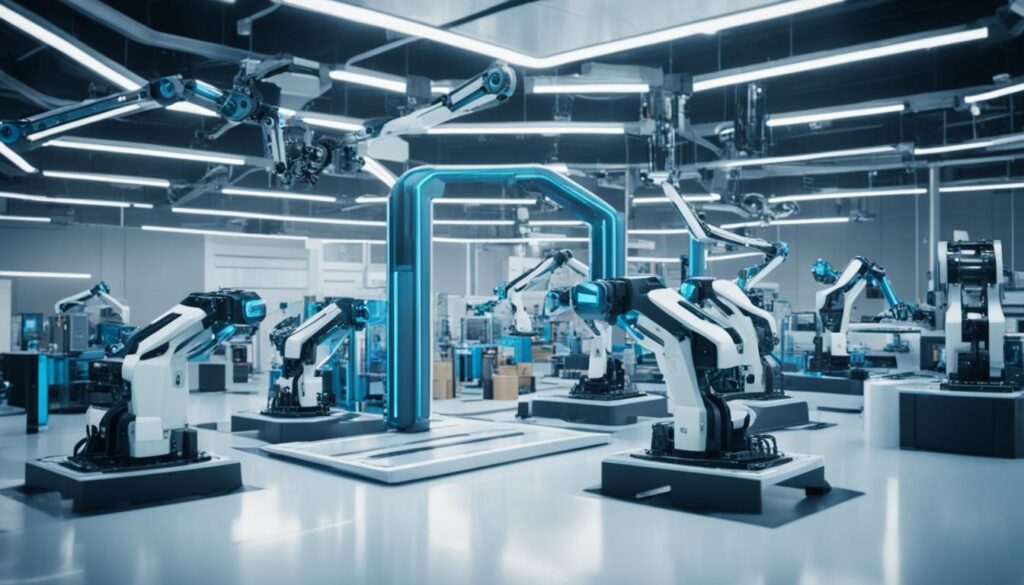Have you ever wondered how SMEs can use AI to change product development? It helps them stay ahead in today’s market.
AI offers amazing chances for SMEs to boost their work, automate tasks, and bring new ideas to life. It helps overcome challenges and makes companies more adaptable. By using AI, SMEs can predict trends, make better decisions, and manage resources more efficiently.
AI’s use in different fields shows its big promise. The AI market could jump from $208 billion in 2023 to $2 trillion by 20301. This means businesses could see their earnings grow by 6% to 10% with AI1. AI can improve areas like finance, supply chain, sales, and marketing. It makes small businesses more innovative and their operations smoother.
Key Takeaways
- AI product development for SMEs can significantly boost productivity and automate non-routine tasks.
- The global AI market is projected to grow exponentially, providing vast opportunities for SMEs1.
- Adopting AI can lead to revenue increases of 6% to 10% for SMEs1.
- AI’s role in business forecasts, decision-making, and asset management is crucial for enterprise scalability.
- Accurate and reliable data are essential for the successful implementation of AI in SMEs1.
Introduction to AI in Product Development
AI has changed how we make products. More data, better computers, and smarter algorithms help create new things. SMEs can use AI to do hard jobs automatically, make better choices with predictions, and lead with new market ideas.
Why SMEs Need AI
For SMEs, using AI is now a must in making products. A KPMG survey says 15% of SMEs in Poland have already got AI working for them2. Another 13% plan to use it2. This fact shows how vital AI is for SMEs wanting to upgrade and compete. AI can boost how much work employees do by up to 40%, says the Boston Consulting Group2.
The Growing Importance of AI
AI is becoming more crucial fast. It’s thought AI software will make $100 billion by 20253. SMEs have lots of AI tools — over 13,000 — to pick from. This helps them be more creative and flexible2. Nine big companies lead the global AI solution sales, 42% of which comes from North America3. Among these, six are big U.S. tech names like Google, Microsoft, and Amazon. Three are big firms from China3.
But, adopting AI is hard for SMEs because of the high costs, not enough data culture, and limited in-house skills. Policymakers and governments are key to closing this gap. They support data culture growth and better digital risk managing. This help makes it easier for small companies to start using technology.
How AI is Transforming Product Design
AI is changing how products are designed, especially for small and medium businesses. At the heart of this change is Generative AI4. It makes new content by learning from existing data. SMEs are using tools like GANs and VAEs to improve their designs4.
Advancements in Generative AI
Generative AI is opening new doors for small businesses. It lets designers try out many designs quickly. This leads to more creativity4.
But, small businesses face hurdles like understanding AI and limited budgets. Despite this, the advantages include standing out to customers and boosting creativity4. Using generative AI helps in making unique products and enhancing the customer experience4.
Efficiency and Innovation Boost
AI makes the design process faster by automating it. This speed helps small businesses offer personalized designs and quick prototypes. These efforts improve their standing in the market4.
A survey in a webinar showed businesses see big benefits from generative AI. These include better data analysis and product development. It also helps in improving processes and engaging customers4. By embracing AI, small businesses can be more efficient, innovative, and competitive.
Prototyping with AI: Accelerating the Process
Integrating AI into prototyping helps SMEs quickly improve product designs. It makes the development process smoother. This way, businesses can meet customer needs and handle market changes well. AI-driven prototyping speeds up making new products. It gives SMEs the edge they need to stay ahead.
Use of AI in Rapid Prototyping
Generative AI lets SMEs make prototypes fast by automating design creation5. It saves time and effort, getting products to market quicker6. The AI Design Sprint model helps teams come up with and test new ideas quickly. It ensures prototypes meet what customers want7.
Cost and Time Benefits
Using AI in prototyping saves money and time. Generative AI streamlines work and automates routine tasks, lowering costs5. This fast-tracks adapting to the market and suggests the best inventory levels, cutting storage costs6. Spending on AI services is expected to grow, showing its value to businesses7.
| Aspect | Benefit | Details |
|---|---|---|
| Time Savings | Accelerates Development | Generative AI reduces prototype iteration time5 |
| Cost Savings | Reduces Expenses | Optimizes operations, cuts costs in prototyping6 |
| Market Adaptation | Enhances Agility | Enables quicker response to market changes5 |
| Resource Allocation | Strategic Utilization | Automates tasks, frees up resources for innovation5 |
AI-Driven Product Personalization for SMEs
Today, small and medium enterprises (SMEs) can stand out by personalizing products with AI. This tech helps them understand what customers like and how they behave.

Understanding Customer Preferences
AI can sift through lots of customer data for better insights. For SMEs, using AI could mean a revenue jump of 6% to 10%. This boost comes from knowing exactly what customers need1.
Having data that’s both accurate and relevant is key. It makes sure the personalized products hit the mark1. Cloud ERP systems are also vital, making it easier to blend AI into the business1.
Creating Unique User Experiences
Using AI, SMEs can make products that truly meet each customer’s needs. This approach improves how users feel about the brand, and they’re likely to stay loyal1.
For instance, AI can offer very tailored product suggestions. This strategy not only grabs customer attention but also boosts sales1. By focusing on what the customer wants, SMEs can really stand apart from competitors, growing their presence in the market1.
Applying AI in Product Ideation
AI transforms the way small and medium enterprises (SMEs) come up with ideas. It introduces sophisticated tools for ideation. By using generative AI, companies can create content faster, better, and more relevantly5. This speeds up making new products and brings new innovations easier for SMEs5.
AI helps SMEs come up with new ideas automatically. This sparks new inventions that meet what customers want5. The AI ideation process follows four steps: identifying problems, generating solutions, evaluating them, and choosing the best ones8. Techniques like machine learning help in finding these solutions8.
AI also looks at trends and customer opinions to help make better products. This makes products more innovative and fitting to what people need. Using AI for brainstorming helps SMEs create ideas that truly match what customers look for.
The courses offered help developers and product managers make AI products focused on users8. This approach makes sure AI ideation is creative and follows the best practices. It helps in making products that perform well and are adopted by users.
Visualization and Customization with AI
AI boosts product visualization and customization for SMEs. This provides immersive experiences, showing products in real settings. It helps customers see products clearly before buying. This increases customer happiness and loyalty.
Enhanced Product Visualization
AI makes product visualization realistic. This helps customers imagine products in different places. It leads to better buying choices.
Using AI, companies can understand big data, like market trends. This improves how they show products9. AI helps match products with what customers want.

Customization Capabilities
SMEs use AI to customize products for each customer, which makes buyers happier. AI adapts products to personal tastes, making experiences special. AI’s flexible pricing helps companies set better prices by studying the market9.
Customizing helps build a loyal customer base. About 48% of customers want special treatment for their loyalty9.
Role of AI in Process Automation
Nowadays, using AI for process automation is key for small businesses to keep up. AI helps in many business areas, making things more efficient.
Streamlining Business Operations
AI can save small businesses lots of time and effort on boring tasks. For example, AI devices can manage stocks and ensure products are delivered on time10. They also get better over time by learning from data10.
Studies show that AI can make workers 40% more productive, like at the Boston Consulting Group2.
Reducing Manual Errors
Another big plus of AI is making fewer mistakes. It can spot security risks early and prevent cyberattacks, which is super important today2. Mastercard’s AI, for instance, can catch fraud super fast, much quicker than old methods2.
A survey by KPMG showed that 15% of small businesses in Poland started using AI last year. Another 13% plan to use it soon2. This shows more companies see how AI can make their work better and cut down on errors.
Process Scalability through AI
AI provides solutions that grow with small and medium businesses. It adapts easily, integrating into expanding operations. This ensures businesses keep improving in efficiency and productivity.
Scalable AI Solutions
Thanks to machine learning and cloud tech, small and medium enterprises (SMEs) can use AI that grows with them. These tools help automate tasks, analyze big data, and offer insights for better decisions11. AI algorithms let SMEs understand what customers like. This helps make marketing and products more personal, increasing customer happiness and loyalty11. AI’s flexibility allows businesses to grow and handle more work smoothly.

Adapting to Business Growth
AI helps businesses grow by predicting market trends and tailoring customer experiences11. This means they can handle more work and data as they expand. Over 80% of leaders think AI is key for growth, says Accenture12.
To grow with AI, using it to streamline tasks and make better predictions is vital11. This reduces delays in operations. Starting with AI on a small scale can help manage costs and increase knowledge among SMEs11. Investing in training and working with experts empowers SMEs to use AI effectively. This gives them an edge in the market.
How Can AI Product Development SMEs Benefit?
AI gives small and medium-sized businesses a big edge. In Poland, 15% of SMEs started using AI last year, with another 13% planning to2. Integrating AI can up productivity by to 40%2. It does this by automating simple tasks and making work flow better. This way, companies can focus on bigger goals.
AI also helps businesses make smarter choices. It does this with tools that look at lots of data and find important trends2. These tools let businesses make choices based on solid info. They stay competitive this way11. For example, Mastercard uses AI to spot fraud in just 50 milliseconds. This shows how quick and accurate AI is2.
Using AI for making products can also cut costs a lot. It makes managing things and doing business smoother11. Plus, AI helps offer customers personalized service. This makes customers happier and more loyal. It works by studying customer info and sending them special offers11.
But, to really succeed with AI, small businesses must face some tough parts. This includes training staff and handling the costs11. A good plan is to start small and build up. Teaming up with AI pros can also help11. This way, SMEs can fully use AI’s perks while avoiding risks.
Keeping AI systems up to date is key for keeping up the gains2. Also, being clear and responsible about using AI is crucial from the start, especially with data privacy2. Following these steps, SMEs can use AI to boost innovation, productivity, and long-term growth. This makes them strong rivals in the market.
Opportunities with Generative AI for SMEs
Generative AI is a game-changer for SMEs looking to up their game. It makes creating content faster and cheaper5. Now, businesses can keep content fresh without breaking the bank.
This change lets companies focus on big goals as AI handles content5. They can dive into growth and innovation, leaving routine tasks to technology.
Innovative Applications
Generative AI helps SMEs make new products faster. It speeds up design and brings new ideas to the table5. This tech not only makes development quicker but also boosts creativity5.
It also lets companies make shopping personalized for every customer5. This sets them apart in crowded markets.
New Business Models
Generative AI is key in crafting cutting-edge business strategies. It empowers SMEs to better market products and streamline shopping4. Automated tasks mean companies run smoother and faster5.
By using data like CSAT scores, firms can see how well they’re doing4. This feedback guides them to improve and innovate.
Still, small businesses might struggle with using generative AI. Challenges like learning the tech, budgeting, and finding skilled people can arise4. Overcoming these hurdles is possible with the right training and investments4.
Limits and Challenges of Using AI
Bringing AI into small businesses opens many doors yet also brings problems. One big issue is keeping data safe. AI needs a lot of data to work well. But handling this data safely is tough, especially for businesses trying to make the most out of AI on a large scale13. Keeping data safe is crucial for keeping people’s trust and following strict laws.
Data Privacy Concerns
AI gives small businesses powerful tools, but handling data safely is complicated. It requires serious safety steps. We need to watch out for fairness and keep AI results clear to avoid biases13. Also, we have to protect creative rights, stressing why we need strong rules for data safety11. As companies use more customer data, following privacy rules becomes a must.
Technical and Financial Barriers
Technical issues are big hurdles for small businesses using AI. There aren’t enough experts in AI around13. This situation makes many small businesses hire outside help, bringing extra costs and other problems13. Plus, AI is expensive to start and keep going, which is tough for small businesses13. Money problems make it hard for them to get the tech and people they need for AI.
To face these technical challenges, companies need a plan and to invest in learning. Issues like how long it takes to set up AI, ethical worries, and risks of losing jobs to robots add to the challenge13. Also, not knowing about the latest AI can stop small businesses from using it fully13. They need to work with tech companies and train their people to overcome these obstacles.
Best Practices for Implementing AI in SMEs
To successfully use AI, SMEs need a careful plan. The key is looking at what the business needs, how to use resources, and how to handle risks. Using AI right can help a business meet goals, work smarter, and grow.
For SMEs to reach their goals, having a solid AI strategy is a must. Right now, over half of AI efforts fail because they don’t have a clear plan12. Small businesses should focus on AI areas that offer quick wins and good investment returns12. By automating with AI, companies can cut down on mistakes and save time in software development12. They should also use AI tools from big tech firms since making their own might not be practical14.
Risk Management
When SMEs adopt AI, they also need to manage risks like data security and ethical issues. With a lot of companies having scattered data, it’s important to bring data together to make better decisions12. Training staff well is key to making AI work14. By overcoming these hurdles, small companies can really benefit from AI, from forecasting customer trends to improving how they manage inventory15. With smart risk plans and a focus on gathering top-quality data, SMEs can tackle AI’s challenges well14.
FAQ
Why do SMEs need AI integration in product development?
What are the growing importance and advantages of AI for SMEs?
How is generative AI advancing product design?
What are the benefits of using AI in rapid prototyping?
How does AI-driven product personalization enhance customer relationships?
How can AI assist in the product ideation phase?
What role does AI play in product visualization and customization?
How does AI streamline business operations through process automation?
In what ways can AI assist in scaling business processes?
What are the main benefits of AI for product development in SMEs?
What opportunities does generative AI present for SMEs?
What are the limits and challenges of using AI for SMEs?
What are the best practices for implementing AI in SMEs?
Source Links
- https://news.sap.com/africa/2024/03/how-smes-can-transform-their-business-with-ai/
- https://firmbee.com/ai-in-smes-how-can-smes-compete-with-giants
- https://medium.com/@stahl950/the-basics-of-ai-for-smes-part-1-of-5-43e4db385680
- https://www.linkedin.com/pulse/transforming-small-medium-enterprises-generative-ai-helen-yu-wav6c
- https://www.linkedin.com/pulse/empowering-smes-impact-generative-ai-business-growth-javad-ghofrani-dcfle
- https://www.blog.dragon-tail.com/generative-ai-use-cases-for-small-and-medium-enterprises/
- https://medium.com/designsprints-studio/from-zero-to-prototype-in-2-weeks-the-ai-design-sprint-for-products-services-35f9c1312bac
- https://www.linkedin.com/pulse/how-integrate-ai-business-product-mindset-zabi-ulla-nq3ac
- https://simplmsp.com/blog/9-smart-ways-for-small-businesses-to-incorporate-generative-ai
- https://www.oecd-ilibrary.org/sites/01a4ae9d-en/index.html?itemId=/content/component/01a4ae9d-en
- https://www.linkedin.com/pulse/how-ai-being-adopted-smes-priority-leading-businesses-chris-chiancone
- https://amzur.com/blog/practical-guide-to-ai-implementation-strategy-for-smbs/
- https://www.nibusinessinfo.co.uk/content/risks-and-limitations-artificial-intelligence-business
- https://www.linkedin.com/pulse/implementing-ai-practical-guide-smes-rob-may-fiod-frsa-mpsa-prque
- https://www.bitrix24.com/articles/ai-for-smes-a-practical-guide-to-implementing-ai-for-success.php



